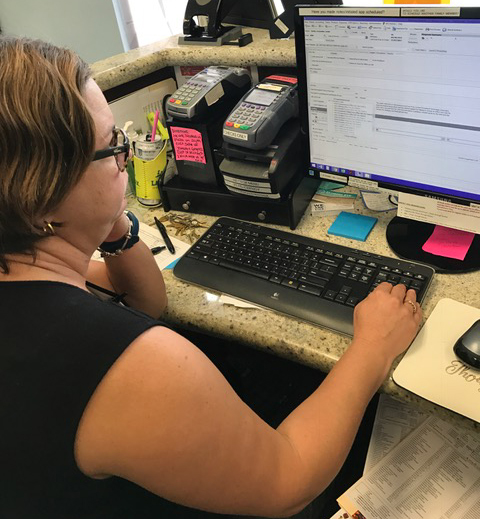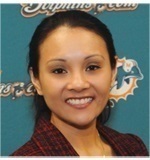By Thuy-Lan Nguyen, OD

Jan. 17, 2018
Approximately 40 percent of my patients are presbyopic, and I expect this number to grow as Millennials move into middle age (the comparatively smaller Generation X is already there). There is an explosion of treatment options for our presbyopic patients, from progressive lenses to multifocal contact lenses. The choices can be overwhelming. It is up to ODs to be aware of the latest in technology, and customize a specific treatment plan for each patient.
In our practice, we have formally scripted the presentation of how innovative optical products now offer solutions to the onset of presbyopia, and can restore youthful vision. Scripting is key to ensuring that our entire team presents this message in a uniform and positive way.
In our practice, each presbyopic patient generates $500-$1,000 in revenue from progressive sales. And if they wear both multifocal contact lenses and progressive glasses, that revenue is closer to $1,500 if you take into account the examination, contact lens evaluation, premium progressives and a year’s supply of multifocal contact lenses.
If I see 20 presbyopes per week, or 80 per month, total revenue ranges from $40,000 to $120,000 per month.
Optimistically, I hope to increase those revenues by 10-20 percent by the year 2020. So, in a few years, revenue could range from $44,000 to $144,000.
 Take Gentle Approach in Breaking the News
Take Gentle Approach in Breaking the News
There is a big emotional aspect to telling a patient about their presbyopia. Even if they present with symptoms of near blur, they may be in denial when it comes to accepting treatment. Many patients do not want to acknowledge that they are getting older. They won’t accept the fact that they may need glasses like their elderly parents.
Modern technology allows the emerging presbyope to push back the need for treatment for a few years. Patients can increase the font size on their devices. They can increase screen brightness. They can use the flashlight on their smartphone in a dim restaurant. And they can use the camera on their smartphone as a digital magnifier. That said, presbyopia is inevitable for most patients. and so is the challenge of breaking the news to a first-time presbyope.
I often kid around with patients and tell them: “You are growing up. You’ve hit the magic age.” I follow-up with: “I’m right there with you.” If they laugh at my little joke, sometimes I keep them laughing by saying, “I’m going to put my arm-stretcher on you for a few minutes, then you’ll be fine.”
How to Answer Common Questions
The most common question I get from patients is whether there are any exercises they can do to prevent their vision from getting worse. Or some patients will ask me if there is any medication they can take to prevent the changes. I respond by saying, “If there were magic exercises, or a magic pill I could prescribe to cure you of your presbyopia, I’d have patients lined up around the block and I’d be a rich woman.”
Patients will also often ask about surgical options for presbyopia. I tell them, there may be options with LASIK, and while LASIK technology has improved in recent years, there is still a likelihood that they will need glasses for certain situations. Even the best of LASIK will only make a presbyopic patient less dependent on glasses or contact lenses. There is no magic surgery that will guarantee that they never have to wear glasses again.

One of Dr. Nguyen’s patients wearing progressive eyewear in her workplace. Dr. Nguyen says it’s important to discuss all of the patient’s lifestyle needs when addressing presbyopia.
Review Options with the Patient
Near Sighted & Just Wants to Remove Glasses to See Up Close
The myope, who is currently only wearing glasses, may feel more comfortable simply removing their glasses for near visual tasks. They will tell me that they see fine up close without their glasses on.
Rather than pressure the patient to try progressives and multifocals, acknowledge and agree with them that in the early stages of presbyopia taking their glasses off for near tasks can be a solution.
Next, a myopic patient needs to understand that this has been true their whole life, and the fact that they can read without their glasses has not changed. But if they want to be able to read without taking their glasses on and off all day, then they need progressive glasses.
When They’re Mostly CL Wearers
A myope, who is mostly a contact lens wearer, has many more choices. Do they want to wear glasses for reading over their contact lenses? If yes, the solution is fairly straightforward. Most myopes, who wear contact lenses, do so because they don’t want to wear glasses during the day, so just prescribing reading glasses may not be appropriate for them. This is when I introduce multifocal contact lenses. Multifocal contact lens technology has improved dramatically in the last few years, so I rarely prescribe monovision contacts to the new presbyope.
When They’ve Never Worn Glasses Before
The hyperopic presbyope is significantly more challenging to get through to. They have likely had good acuity, near and far, their entire life, and now both distance and near vision are blurry. They are likely in a deeper denial about needing visual correction. Many would prefer to go right into contact lenses. They often won’t even entertain the thought of glasses.I tell them that contact lenses may be available to them, but they need glasses first. And they may need glasses full time first. Once they have proper glasses, then I will fit them with multifocal contact lenses.
The emmetrope presbyope is the most challenging to fit with contact lenses. Multifocal lenses may degrade their clear distance vision and monovision may limit their range of vision. And they are in the most denial because they have never worn glasses or contact lenses, and their distance vision is still clear without correction. In this situation, I’ll ask the patient, “Do you want the easiest solution? Or the most cosmetic solution?” If they want the easiest, or the most simplified solution, I prescribe reading-only glasses. But if they are more concerned about cosmetics, and they don’t want to wear “grandma reading glasses,” then I discuss multifocal contact lenses first. However, I inform them that even the best of contact lenses will not give them the same clear, stable vision they had in their twenties. And they may still need reading glasses for certain situations, especially when lighting is not ideal.
Address Unique Lifestyle Needs
Stay up-to-date on the newest progressive spectacle lens designs. The presbyopic truck driver will require a different progressive design than the accountant. And the 58-year-old accountant may need a different design when they play golf on the weekends. And the Gen Xer, who is an avid golfer, may need a different design when they are watching a tournament on their tablet compared to when they are playing on the golf course.
Progressive lenses are no longer “one size fits all.” Prescribing new technology not only meets the patient’s individual needs, and increases revenues generated, but it shows patients that you care about them on a more personal level. This is what keeps a patient coming back to you year after year, instead of looking for lower-cost alternatives online.
Set the Stage for the Sale
Once I have built a rapport with the patient, and discussed with them what they want, then I explain my prescription. At this point, I am not giving them any more options. Options are “optional.” Now I’m prescribing them what is best for their needs. If the patient responded to my lighthearted jokes, then at the handoff, I’ll tell my optician, “Mr. X is ready for his first pair of grown-up glasses.” Or sometimes, I’ll say, “Mr. X’s arms are too short, but our arm-stretcher is broken, so we are going with plan B.” My optician knows I am prescribing premium progressive, or near-vision glasses, with blue-light technology for reading on digital devices.
Do the Multifocal CL Fitting Right Away
Seize the moment if a patient is receptive to trying multifocal contact lenses, and do the fitting right away, rather than having them back for an additional appointment. If a patient is interested in multifocal contact lenses, and they already have back-up glasses, then I will do the multifocal contact lens examination right away. Even if I intend on using multifocal contact lenses, I still check ocular dominance at the beginning, in case I need to do fine-tuning at the second visit. I provide enough diagnostic lenses for a patient to wear for 1-2 weeks. For the first-time multifocal lens wearer, I won’t finalize the prescription without a second visit. Even if they love the vision and the comfort, I use the second visit as an opportunity to remind them of the importance of good lighting when reading and the likelihood of needing additional changes in the future.
Head Off Contact Lens Dropouts
The biggest reason for contact lens dropouts is lack of comfort due to dryness. But when it comes to presbyopia, the patient most likely to drop out of contact lens wear is the low myope who is now presbyopic. If they can see better at near without correction, but you tell them they have to wear glasses over their distance contact lenses to read, they are likely to go back to just wearing glasses for distance vision. These are the patients you have to put into multifocal contact lenses right away. But these are also the easiest patients to fit with multifocals. Newer daily disposable multifocals make it simple and fast. In this case, I often don’t need to give a lot of explanation or education. I just have the patient put on the multifocal lenses. They don’t need to understand many technicalities to see an immediate improvement in their near vision.
 Thuy-Lan Nguyen, OD, teaches at Nova Southeastern University College of Optometry, and works part-time as an associate at We Are Eyes in Boca Raton, Fla. To contact her: TLNGUYEN@nova.edu
Thuy-Lan Nguyen, OD, teaches at Nova Southeastern University College of Optometry, and works part-time as an associate at We Are Eyes in Boca Raton, Fla. To contact her: TLNGUYEN@nova.edu





















